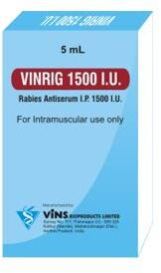
Vinring 1500 I.U. Injection
100 Pack(s) (MOQ)
Our organization is a one-stop stop and the best destination for acquiring superiority guaranteed Vinrig 1500 I.U.. Our products are value for money, as they are subjected to stringent quality control policies and are trusted by many. Composition : Each vial contains Equine anti-rabies immunoglobulin fragments – not less than 300 I.U./ml. Cresol I.P. < 0.25% v/v as a preservative. Glycine I.P. – 0.0225 g/ml Sodium Chloride I.P. – 0.009 g/ml Water for injection I.P. – q.s. Details : Description - Rabies antiserum is a sterile, nonpyrogenic solution for intramuscular administration, containing antiviral substances obtained from the blood serum of healthy equines that have been immunized against rabies by vaccination. In addition, it also contains the antimicrobial agent cresol. Therapeutic Indications - Rabies antiserum provides passive immunization against rabies for prevention of rabies in patients at risk of being exposed to rabies after contact with a rabid animal or an animal presumed to be rabid. Anti-rabies serum itself does not constitute an anti-rabies treatment and should always be used in conjunction with rabies vaccine. Contra-Indications - Should be used with extreme caution in subjects with a history of allergic symptoms or hypersensitivity to equine serum. Special warnings / Precautions for use - Despite the high degree of purification of the serum, it is recommended to perform a skin test before administering Rabies antiserum. The skin test consists of an intra-dermal injection with a 1 - 10 dilution of Rabies antiserum (0.1 ml) on the outside of the forearm so as to obtain an orange ring type appearance (3 mm diameter induration). An equivalent intra-dermal injection of physiological saline solution is used as control. The observations made 15 minutes after intra-dermal injection is considered to be positive if erythema (>6 mm), local oedema or a systemic reaction is observed and the control shows no such dermal reaction. Purified equine rabies immunoglobulin (the active constituent of rabies immunoserum) has been reported to be safe and affordable alternative to human rabies immunoglobulin. (Bulletin WHO 1989, 67(731-732). A positive test result is not a formal contra-indication for the use of sero-therapy, but it should be considered as a warning. In such cases Rabies antiserum should be administered only after ensuring the facility to overcome the anaphylactic shock. A negative test is not an absolute guarantee for the absence of an immediate allergic type reaction. Drug Interactions - Rabies prevention after contamination risk requires simultaneous administration of anti-rabies immunoglobulin and vaccine to be inoculated in different parts of the body, contra-laterally if possible. To minimize interference, the antiserum should not be administered from the same syringe as the vaccine. Pregnancy / Lactation - The safety of rabies immunoserum when used during pregnancy has not been established in clinical trials in human beings. Considering the lethal risk associated with rabies, pregnancy may not a contraindication to the administration of rabies immunoserum subsequent to exposure. First aid treatments - Prompt local treatment of bite wounds and scratches that may be contaminated with rabies virus is important, whatever the time elapsed since the contact. Recommended first-aid procedures are imminent thorough flushing and washing of the wound with soap and water, detergent or other substance of proven lethal effect on rabies virus. The rabies immunoserum should be injected as soon as possible after exposure. For prevention of rabies combined immunoglobulin-vaccine treatment is recommended. The recommended dose is 40 I.U./KG of body weight. If anatomically feasible, as much as possible of the dose should be infiltrated around the wounds. The remainder should be administered intramuscularly (into the gluteal region) in a single dose. The first dose of the vaccine should be inoculated at the same time as the immunoglobulin, but in different parts of the body. Children and adults receive the same dose of 40 I.U. /Kg of body weight. When indicated, begin anti-tetanus treatment and administer anti-microbial drugs to control infections other than rabies. Adverse effects - Immediate or delayed hypersensitive type reactions may be developed on administration of rabies immunoserum. The observed immediate reactions are anaphylactoid reactions with hypotension, dyspnoea, and urticaria. Delayed reactions consist of inflammatory reaction, fever, pruritis, rash or urticaria, adenopathy and arthralgia. Storage - Store at a temperature between +2oC and +8oC in a refrigerator, DO NOT FREEZE. Presentation - Vials containing 1500 I.U. (5 ml).
Condition : New Fresh Stock
...more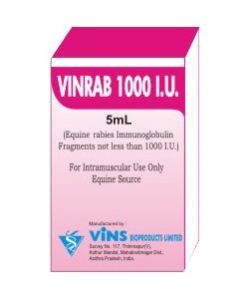
Vinrab 1000 I.U Injection
100 Pack(s) (MOQ)
Rabies antiserum is a sterile, nonpyrogenic solution for intramuscular administration, containing antiviral substances obtained from the blood serum of healthy equines that have been immunized against rabies by vaccination. In addition, it also contains the antimicrobial agent cresol.Composition : Each vial contains - Equine anti-rabies immunoglobulin fragments – not less than 300 I.U./ml. Cresol I.P. < 0.25% v/v as a preservative. Glycine I.P. – 0.0225 g/ml Sodium Chloride I.P. – 0.009 g/ml Water for injection I.P. – q.s. Therapeutic Indications : Rabies antiserum provides passive immunization against rabies for prevention of rabies in patients at risk of being exposed to rabies after contact with a rabid animal or an animal presumed to be rabid. Anti-rabies serum itself does not constitute an anti-rabies treatment and should always be used in conjunction with rabies vaccine.Contra-Indications : Should be used with extreme caution in subjects with a history of allergic symptoms or hypersensitivity to equine serum.Special warnings / Precautions for use : Despite the high degree of purification of the serum, it is recommended to perform a skin test before administering Rabies antiserum. The skin test consists of an intra-dermal injection with a 1 : 10 dilution of Rabies antiserum (0.1 ml) on the outside of the forearm so as to obtain an orange ring type appearance (3 mm diameter induration). An equivalent intra-dermal injection of physiological saline solution is used as control. The observations made 15 minutes after intra-dermal injection is considered to be positive if erythema (>6 mm), local oedema or a systemic reaction is observed and the control shows no such dermal reaction. Purified equine rabies immunoglobulin (the active constituent of rabies immunoserum) has been reported to be safe and affordable alternative to human rabies immunoglobulin. (Bulletin WHO 1989, 67(731-732). A positive test result is not a formal contra-indication for the use of sero-therapy, but it should be considered as a warning. In such cases Rabies antiserum should be administered only after ensuring the facility to overcome the anaphylactic shock. A negative test is not an absolute guarantee for the absence of an immediate allergic type reaction.Drug Interactions : Rabies prevention after contamination risk requires simultaneous administration of anti-rabies immunoglobulin and vaccine to be inoculated in different parts of the body, contra-laterally if possible. To minimize interference, the antiserum should not be administered from the same syringe as the vaccine.Pregnancy / Lactation : The safety of rabies immunoserum when used during pregnancy has not been established in clinical trials in human beings. Considering the lethal risk associated with rabies, pregnancy may not a contraindication to the administration of rabies immunoserum subsequent to exposure.First aid treatments : Prompt local treatment of bite wounds and scratches that may be contaminated with rabies virus is important, whatever the time elapsed since the contact. Recommended first-aid procedures are imminent thorough flushing and washing of the wound with soap and water, detergent or other substance of proven lethal effect on rabies virus. The rabies immunoserum should be injected as soon as possible after exposure. For prevention of rabies combined immunoglobulin-vaccine treatment is recommended. The recommended dose is 40 I.U./KG of body weight. If anatomically feasible, as much as possible of the dose should be infiltrated around the wounds. The remainder should be administered intramuscularly (into the gluteal region) in a single dose. The first dose of the vaccine should be inoculated at the same time as the immunoglobulin, but in different parts of the body. Children and adults receive the same dose of 40 I.U. /Kg of body weight. When indicated, begin anti-tetanus treatment and administer anti-microbial drugs to control infections other than rabies. Adverse effects : Immediate or delayed hypersensitive type reactions may be developed on administration of rabies immunoserum. The observed immediate reactions are anaphylactoid reactions with hypotension, dyspnoea, and urticaria. Delayed reactions consist of inflammatory reaction, fever, pruritis, rash or urticaria, adenopathy and arthralgia.Storage : Store at a temperature between +2oC and +8oC in a refrigerator, Do Not Freeze.
Condition : New Fresh Stock
Application : Pharmaceutical
...more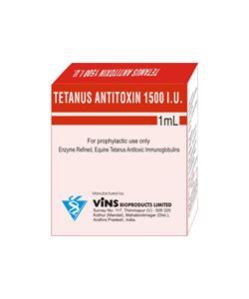
Tetanus Antitoxin 1500 I.U. Injection
100 Pack(s) (MOQ)
Backed with industrious professionals, we keep a stern check on the products to ensure that the range is commensurate to international norms. We have a strong distribution network, owing to which we efficiently transport the goods to the desired place. Administration: Tetanus antitoxin is given prophylactically to persons at the risk of tetanus infection by infected wounds or severe wounds. A dose of 1500 IU should be given intramuscularly or subcutaneously and the dose may doubled or trebled in case multiple and severe wounds. Prophylactic dose is also given in surgical operations as post operative care. Along with this passive immunization it is advisable to initiate active immunization with adsorbed Tetanus toxoid. Indications : Tetanus antitoxin neutralizes the toxin produced by Clostridium tetani; the toxin has high affinity for new cells and antitoxin is unlikely to have an effect on toxin that is no longer circulating. Tetanus antitoxins have been used to provide temporary passive immunity against tetanus but tetanus immunoglobulins are preferred (Reynolds, 1990; McEvoy et al. 1988). Human globulin offers the advantage of greater protection, a lower risk of adverse effects and requires only one-tenth of the dosage compared to antitoxin of animal.Contraindications : Sensitivity testing (e.g., skin test, conjunctival test) should be conducted in all individuals, regardless of clinical history, prior to administration of tetanus antitoxin. In case of patients receiving tetanus antitoxin serum, it should be essential to test for hypersensitivity of the individual with a test dose. Serum sensitivity test is carried out by injecting 0.1 ml serum in 1:10 dilution either subcutaneously or intracutaneously and observing for half an hour for any reactions of local or general. In case of hypersensitive reaction, serum should be given with great caution in small divided dose subcutaneously at regular intervals of half an hour. Injection adrenaline (1:1000) must be at hand for immediate treatment of shock, if it develops. Intravenous administration of serum is not recommended in hypersensitive cases. In some cases symptoms as itching, urticarial rash, pains in joints and muscles, fever, enlargement of lymph glands, appear about 7-12 days after injection of serum. These should be treated with antihistamines and corticosteroids. Usually these symptoms of serum sickness last a few days and patients recover without any complication. Storage : The liquid Tetanus antitoxin should be stored between 2o and 8o C. It should not be allowed to freeze. Freeze-dried Tetanus antitoxin can be stored in a cool, dark place or in a refrigerator, if available. Reconstituted liquid should not be stored for a long time and should not be allowed to freeze.Presentation : Tetanus antitoxin is supplied as 1 ml liquid in glass vial/ ampoule and also supplied as freeze-dried powder with 1 ml of Water for Injection I.P. for reconstitution.Disposal : Left over antiserum and used vials should be discarded as biomedical waste.
Type : Tetanus Antitoxin
Application : it is use an Antitoxin Agin Tetanus Toxoid
Condition : New Fresh Stock
...more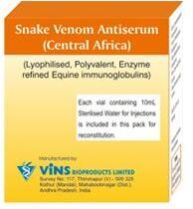
Snake Venom Antiserum (Central Africa) Injection
100 Pack(s) (MOQ)
Polyvalent Snake Venom Antiserum (Central Africa) is prepared from hyper-immunised equines against the venoms of the corresponding venomous snakes, namely - Gaboon Viper (Bitis gabonica rhinoceros) - 0.60 mg Russells Viper (Vipera russelli) - 0.60 mg Saw-scaled Viper (Echis carinatus) - 0.45 mg Black mamba (Dendroaspis polylepis) 0.45 mg Plasma obtained from the hyper-immunized equines is enzyme refined, purified and concentrated. Each mL of the Snake Venom Antiserum (after reconstitution to 10 mL for lyophilised form) neutralizes not less than the following quantities of venoms when tested in mice - Gaboon Viper 0.60 mg Russells Viper 0.60 mg Saw scaled Viper 0.45 mg Black mamba 0.45 mg Snake envenomation is serious and could be life threatening. The consequences of the action of snake venoms vary considerably based on the group to which the particular venom belongs. This, in turn depends upon the composition of the venom. In envenomation by viperid and crotalid snakes, venom (Cytotoxic) breaks down tissues destroying the red blood cells, e.g. Gaboon viper, Russells viper and Saw scaled viper.
Application : Pharmaceutical
...more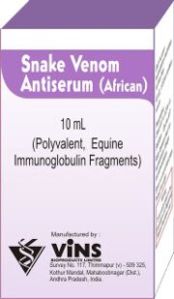
Snake Venom Antiserum (Africa) Injection
4 Per Unit
100 Pack(s) (MOQ)
Snake Venom Antiserum (African) is a sterile preparation contains equine immunoglobulin fragments F(ab’)2. Freeze dried powder is reconstituted in 10 ml of sterile water for Injection supplied along with the vial. Each ml has power of specifically neutralizing the venoms of following species of snakes.
Type : Anti Snake Venom
Application : Hospital
Shelf Life : 4 Yrs
Grade : Medicine Grade
Purity : 99%
Form : Powder
Dosage Form : Injection
Packaging Type : Glass Bottle
Packaging Size : 10 Ml
Medicine Type : Allopathic
Country of Origin : India
...more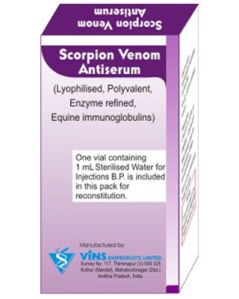
scorpion venom antiserum Injection
100 Pack(s) (MOQ)
Capturing the market with our exceptional product range, we are located in Chengannur(India) and cater to the wide market. Backed by a team of deft professionals, it has become easy for us to furnish divisive demands of the buyers and that too within shortest time possible. Description : Polyvalent anti-scorpion venom serum is prepared from the purified plasma of healthy horses, which have been hyperimmunized against venom of the most dangerous scorpions mentioned below. The antivenin is purified by pepsin degestion, controlled heating and precipitation by caprylic acid followed by sterilizationComposition : Each 1 ml serum contains antibodies that neutralize the following venoms Leiurus quinquestraitus 50LD50 Androctonus ameoreuxi 35LD50 Paraspecifically : Androctonus crassicauda Androctonus aeneas Androctonus australis Scorpiomarus palmatus Bathus occitanus Ortho-Cresol (preservative) 0.25% Protein 17% Grades of Clinical Picture Serverity : Grade 0 - No Local or Systemic Signs. Grade I - Local Signs, pain, and / or parathesia at the site of string. Grade II - Local Signs and pain + remote pain and / or parathesia. Grade III - Local pain + cranical, autonomic or somatic neuromuscular dysfunction. Details : Indications - Treatment of envenomation from the stings of the scorpion species mentioned in composition. Clinical Pharmacology - Venom from a single scorpion may contain several neurotoxins such as histamine, serotonin and enzymes. The most important clinical effects of envenomation are neuromuscular, neuroautonomic or local tissue effects. Dosage / Administration - The product is given by intramuscular, subcutaneous or intravenous injection. The dose is not related to the age or body weight. A skin test must be done before giving anti-scorpion venom serum (see under precautions) NB - In grades I, II and III, the dose may be repeated after 1-2 hours if improvement has not occurred. The dose should be increased if the interval between the sting and the treatment is prolonged or the site of the sting is on the head, neck or shoulders. Place ice on the sting site and immobilize the stung limb to reduce pain and venom extension. Reconstitution of the Lyophilized Antiserum - Remove the flip off on the seal over the diaphragms of the vials of antivenin and diluents. Sterilize the rubber diaphragm with alcohol. Withdraw the diluent in a sterile syringe. Insert the needle through the stopper of the vial containing antiserum and point the diluent jet to the center of lyophilized pellet to be dissolved and in order to prevent floating. Swirl the vial gently for one to five minutes and do not shake to avoid foaming. Adverse effects - Anaphylaxis to horse serum may occur in some rare cases with hypotension, dyspnea, urticaria and shock. Adrenaline injection (1 - 1000), antihistamines and corticosteroids should be readily available. Serum sickness may occur 7-10 days after injection of the antitoxin serum including fever, vomiting, diarrhea, joint and muscle pains, lymphadenopathy, bronchospasm and urticaria. Nephritis, myocarditis, neuritis, polyarthritis and uveitis have been reported as rare complications of serum sickness. It is treated with Contraindications - Allergy to horse serum - Use with caution in allergic cases such as asthma or infantile eczema. Precautions - Intradermal skin test should be done before giving antiscorpion venom serum - Inject 0.1-0.2 ml of (1 - 10 dilution) antivenom intradermally. In case of past history of allergy (1 - 100) dilution should be used. Positive skin test is in the form of a sheal with or without surrounding erythema within 30 minutes. Some studies showed that using low dose of subcutaneous epinephrine of parallel infusion of hydrocortisone and antihistamine can reduce adverse reactions, which may occur with the antivenom. Safety of the product during pregnancy and lactation has not been established; therefore benefit of using the product should be outweighed against the harm. There are no reported drug interactions with the antiscorpion serum. The antivenom should not be used if turbid, expired or showing precipitation Shelf life - Five years from the date of manufacturing for the lyophilized form. Storage - The freeze-dried vial should be stored between 2o and 8o C. Reconstituted liquid should neither be stored for long nor be allowed to freeze. DO NOT FREEZE. Presentation - Scorpion Venom Antiserum Polyvalent is supplied as freeze-dried powder in glass vials along with 1 ml sterile water for injection. Disposal - Left over antivenom and used empty vials should be discarded as biomedical waste.
Shelf Life : 5 Years
Country of Origin : India
...more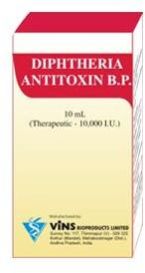
Diphtheria Antitoxin B.P. Injection
100 Pack(s) (MOQ)
From catering to seasonal demand to a continuous one, we can do it, as we have an ultramodern storage facility, which is equipped with the latest inventory control and management system. Clients can select any payment mode from our online or offline methods. Both of them are secure, hassle free, and ensure the fastest trade with the customers. Composition - Each ml contains - 1000 I.U. Enzyme refined, equine immunoglobulin solution Cresol IP (Preservative) - not more than 0.25%v/v Use in Prophylaxis. The use of Diphtheria Antitoxin is not recommended for prophylaxis as its protective effect is of short duration (1 to 2 weeks only) and furthermore, it may cause sensitization to horse sera. Instead, the contacts of Diphtheria patients should receive a dose (0.5 ml) of diphtheria vaccine (Diphtheria vaccine, Adsorbed PTAP) or adsorbed diphtheria- tetanus vaccine (D-T Vaccine, which protects against both diphtheria and tetanus.) and followed after 1 to 2 months with a second dose. Prophylaxis with diphtheria vaccine is gives protection for many years and is practically free from reaction. Use in Treatment - A dose of 10000 IU to 30000 IU of diphtheria antitoxin may be injected intramuscularly in mild to severe cases of diphtheria and up to 100000 IU in severe cases after testing serum sensitivity (see below for reactions to horse serum). In addition, antibiotics and corticosteroids may be administered. It is advised that after recovery from diphtheria, patients should be actively immunized for long term protection by the use of two doses at interval of 1 to 2 months with adsorbed diphtheria vaccine or with adsorbed diphtheria-tetanus vaccine.Reactions to Horse serum:Injection of diphtheria antitoxin in horse serum sensitive individuals can produce immediate reaction of acute anaphylaxis which could sometimes be fatal unless immediately countered by injecting 1 ml of 1 - 1000 adrenaline intramuscularly. Strict care should be taken to prevent this reaction. Before injection of diphtheria antitoxin, it is necessary to enquire from the patient - whether he/she has had injections of any serum before, whether there is personal or family history of allergy i.e. asthma, eczema or drug allergy. The sensitivity of the patient to the serum is tested by injecting subcutaneously 0.1 ml of diphtheria antitoxin diluted 1:10 and the patient is observed for 30 minutes for local and general reactions. If the test dose shows either local reaction such as wheal and flare or general anaphylactic reaction such as pallor, sweating, nausea, vomiting, urticaria or fall of blood pressure, these should be treated with 1 ml of 1-1000 adrenaline (which should be always be kept handy) before injecting the main dose of diphtheria antitoxin. Half the dose of adrenaline may be repeated 15 minutes later if necessary. In allergic individuals, Diphtheria antitoxin is to be injected 15 to 30 minutes after administration of antihistamines such as injectable pheniramine maleate and injectable hydrocortisone intramuscularly. 1 ml of adrenaline (1:1000) may be injected intramuscularly at the same time as the antiserum. Administration of hydrocortisone or adrenaline may be repeated if necessary. In some cases symptoms such as itching, urticarial rash, pains in joints and muscles, fever, enlargement of lymph gland appear 7-12 days after the injection of diphtheria antitoxin. These should be treated with antihistamines and corticosteroids. Usually these symptoms of serum sickness last a few days and the patients recover without any complications. Storage - Diphtheria antitoxin should be stored at a temperature of between 2ºC and 8ºC. It should not be allowed to freeze. Packing - Diphtheria antitoxin 10,000 I.U. in 10 ml vials. Disposal -Left over used empty vials should be discarded as biomedical waste.
Country of Origin : India
...more
Pharmaceutical Injections

Anti Rabies Injection

tetanus injections

Anti Gas Gangrene Serum
Be first to Rate
Rate ThisOpening Hours